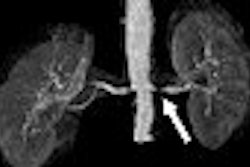Treatment with the chelating agent deferasirox (brand name Exjade) appears to improve cardiac function among patients with thalassemia based on the presence of cardiac iron on MRI T2* scans, according to the preliminary results of an ongoing multicenter trial. These patients are at risk of developing life-threatening cardiac complications in their teens and 20s from iron overload.
"We know that deferasirox can get rid of iron in the body, but we want to make sure it is taking iron out of the heart where it often is a cause of death among these patients," said Dr. John Wood during a poster presentation at the 2007 American Society of Hematology (ASH) meeting in Atlanta.
Wood is the head of cardiovascular MRI at Children's Hospital of Los Angeles (CHLA), and an associate professor of pediatrics and radiology at the Los Angeles-based University of Southern California's Keck School of Medicine. The study is being conducted at CHLA and the Ospedale Regionale Microcitemie in Cagliari, Italy.
Iron cardiomyopathy is the leading cause of death in thalassemia patients, according to Wood, who explained that "once cardiac symptoms become apparent in iron-loaded subjects, decompensation and death occur rapidly unless chelation therapy is dramatically intensified."
"The MRI relaxation parameters T2 and T2* have been used to infer cardiac iron loading in patients with thalassemia," he added. Low T2* at less than 20 msec suggests high myocardial iron and has been associated with poor ventricular function, myocardial arrhythmias, and need for cardiac medications, Wood stated.
He reported on the first six months of an ongoing 18-month trial designed to see if the T2* evidence of cardiac iron can be improved with deferasirox treatment. Patient ages ranged from eight to 18 years for those treated at the Italian hospital and 2.5 years to 17 years at CHLA.
Subjects at both institutions had assessment of cardiac T2* and cardiac function on a 1.5-tesla scanner (Signa CVi, GE Healthcare, Chalfont St. Giles, U.K.). Patients at CHLA also underwent MRI-based liver iron measurements. Wood's group stated in their abstract that measuring iron load is an off-label use of MRI.
According to the results based on 18 of 30 patients, the median cardiac T2* was 30.2 and ranged from 3.4 to 72.8. The baseline average MRI T2* for these patients was about 9 msec. After six months of treatment with 30-40 mg/kg/day, the average MRI T2* was 1.8 msec, a decrease of 14.2%.
Wood said that 14 of the 18 patients evaluated showed a decrease in cardiac iron with deferasirox. Cardiac iron levels also decreased by 22.9% from about 18 mg/g dry weight (DW) to 15 mg/g DW. No drug-related serious adverse events were reported among the 15 patients who were available for follow-up evaluation, Wood said.
Based on these preliminary results, "thalassemia major patients do not accumulate cardiac iron until early in their second decade of life," the researchers concluded. "Consequently, cardiac iron monitoring can be safely deferred until children are able undergo MRI examination without sedation."
By Edward Susman
AuntMinnie.com contributing writer
January 17, 2008
Related Reading
Preliminary study finds fMRI possible in fetal heart, October 7, 2005
MR may be sounder than sonography for catching fetal abnormalities, November 29, 2004
Copyright © 2008 AuntMinnie.com


.fFmgij6Hin.png?auto=compress%2Cformat&fit=crop&h=100&q=70&w=100)





.fFmgij6Hin.png?auto=compress%2Cformat&fit=crop&h=167&q=70&w=250)











